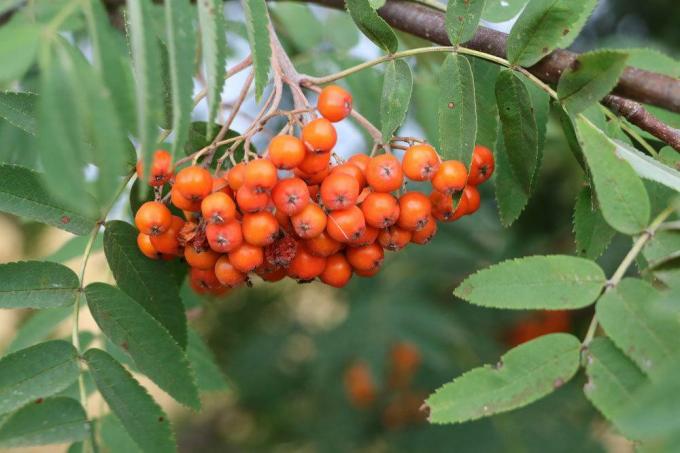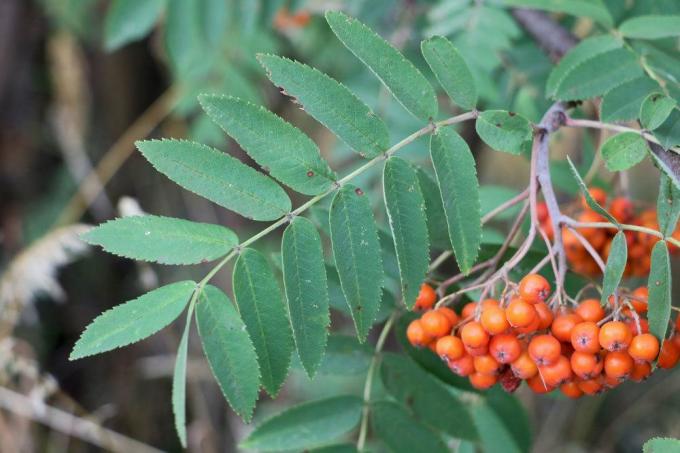
table of contents
- Rowan tree
- Toxicity
- For pets
- What to do when consumed?
- For children
- What to do when consumed?
- edibility
Almost everyone has heard the sentence that rowan berries - also known as mountain ash - are highly poisonous. It is mostly small children who are warned urgently by their mothers and fathers. But is this a myth or is the plant actually highly toxic? And how is it then explained that there is even rowanberry jam?
Rowan tree
Portrait of the rowan tree
Rowan trees are found all over Europe, they are very often on the edges of roads or line avenues. The trees, however, are cultivated in North America. Since there are only minor demands on the soil, the plants, which are up to 15 meters high, thrive for many years without any problems. The tree is recognizable due to its light gray bark on the trunk, which cracks with age, but appears smooth and shiny when young.
Toxicity
Rowan berries as a poisonous plant - which parts are dangerous?
It is actually true that the mountain ash - as rowan berries are also called - is largely poisonous. The fruits are affected, which when unripe can lead to severe gastrointestinal complaints. Nevertheless, the rowan tree is rated as slightly poisonous. The only danger is from unripe fruits, as they contain higher levels of parasorbic acid. Because of this ingredient, the fruit tastes very bitter, so animals such as cats usually do not consume large amounts. The situation is different with the leaves, which do not contain any bitter substances
Tip: All parts of the tree are non-toxic, except for the foliage. This can lead to the formation of hydrocyanic acid in the body in large quantities.

For pets
How toxic are rowan berries to cats and dogs?
Cats are pleasure animals, they usually don't eat anything they don't like. The risk of a cat eating rowan berries in large quantities is low, because the berries are very bitter. But the foliage is usually not despised by the house tiger and there is little toxicity here. There are no life-threatening consequences if consumed, but there is a risk of an impact on the gastrointestinal tract.
The danger is that there is hydrocyanic acid in damaged leaves or that it is formed in the stomach. Hydrocyanic acid attacks the gastrointestinal mucosa and can lead to the following symptoms.
- diarrhea
- nausea
- Vomit
- colic in high doses
What to do when consumed?
What to do if the pet has eaten rowanberries?
As a rule, the rowanberry or the foliage of the tree hardly harm the animals. If symptoms of the gastrointestinal tract occur, symptomatic treatment is sufficient. This consists in relieving vomiting, cramps, and diarrhea. Veterinary supervision may only be required if very large quantities of the leaves have been consumed. The poison control center has important information ready for pet owners.

For children
How toxic is the rowanberry for children?
A child's organism is usually more sensitive than that of an adult. Accordingly, symptoms of poisoning occur more quickly in children and often have more severe symptoms. Unripe rowan berries in large quantities can cause unpleasant gastrointestinal symptoms. As with cats and dogs, affected people suffer.
- Nausea and vomiting
- diarrhea
- Stomach and intestinal cramps
What to do when consumed?
If a child accidentally ingests unripe rowan berries, the pediatrician or the on-call medical service should be contacted to be on the safe side. Even in small amounts, the symptoms can be quickly relieved with appropriate medication. The poison control center is also a good contact.
Consumption of cooked rowan berries is of course not an emergency, larger quantities can be consumed here without overreacting.
edibility
The rowanberry for consumption
Very few people know that rowan berries not only have low toxicity, but are also edible. However, this only applies to the cooked state, raw there is a risk of symptoms of poisoning. The parasorbic acid, which causes the intolerance, is destroyed by the cooking process and no longer does any harm. The fruits are suitable for making jelly, jam or chutney, the taste is reminiscent of cranberries and is often served with game dishes.

Rowan berries not only make an extremely tasty jelly, they are also healthy. The berries contain large amounts of vitamin C, which is why they were considered a remedy for scurvy in earlier years. However, not only the rowan berries are used, but also the foliage and the flowers. This is brewed as a tea used in naturopathy against various ailments. The tea made from rowanberry leaves is often used for bronchitis or colds. However, there is no scientific evidence of its effectiveness.
Sources:
http://geliebte-katze.de/information/katzenhaltung/ernaehrung-der-katze/vorsicht-giftig-fuer-katzen
http://gizbonn.de/231.0.html
http://www.vetpharm.uzh.ch/reloader.htm? perldocs / toxsyqry.htm? inhalt_c.htm% 20_blank% 20external-link-new-window
